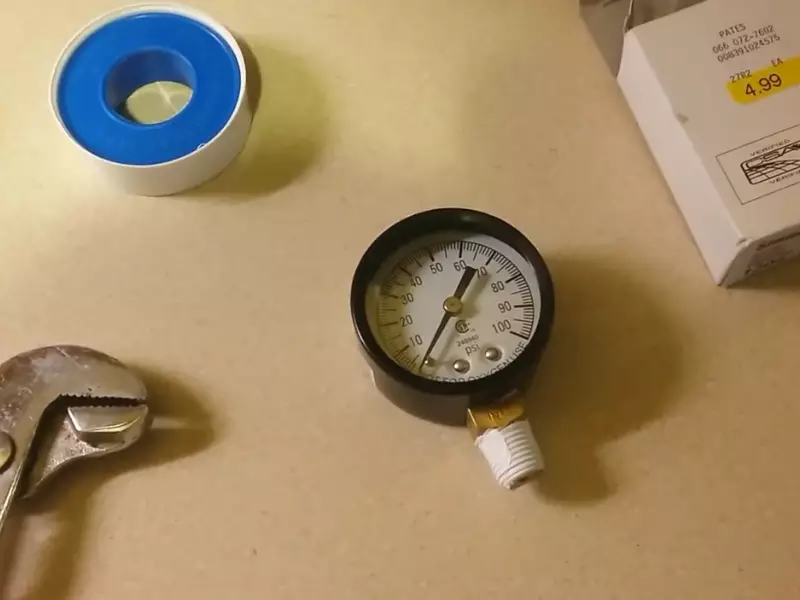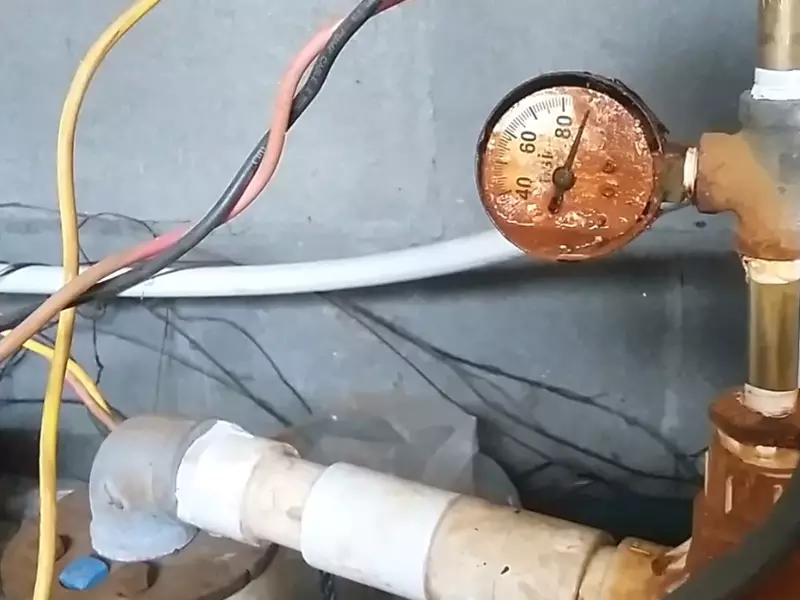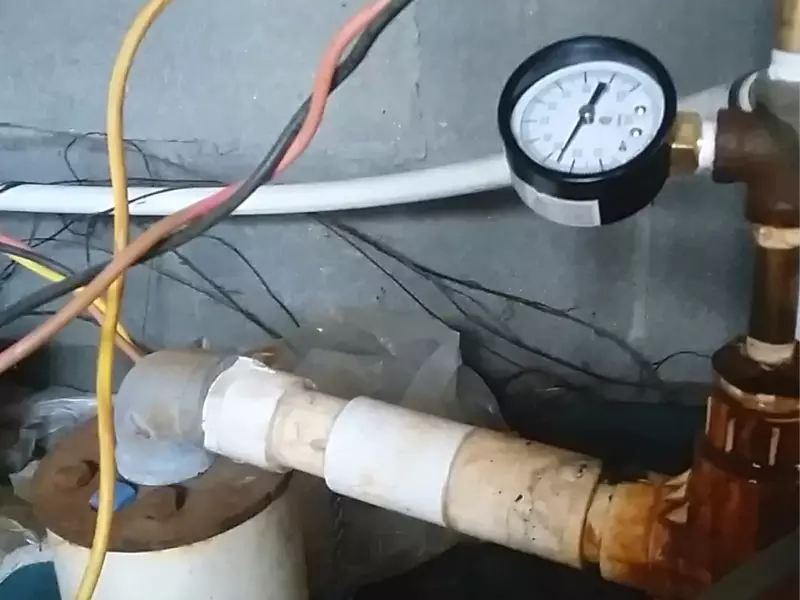A well pump pressure gauge plays a pivotal role in ensuring the efficient functioning of a well system. It indicates the pressure at which the well pump operates, providing insights into the system’s overall health.
A faulty pressure gauge can lead to inefficiencies, increased costs, and potential safety hazards. Replacing it promptly not only ensures smooth water flow but also safeguards the well pump’s lifespan.
Your well pump, its efficiency, and the cost implications largely depend on a functional pressure gauge. Ensuring its regular maintenance and timely replacement can mean the difference between a full supply of water and unexpected disruptions.
Why Replace the Pressure Gauge?
Every component of a well pump system serves a purpose, with the pressure gauge being no exception. Its role, while seemingly minor, plays a significant part in ensuring the entire system works harmoniously. Therefore, understanding the reasons behind its replacement is crucial.
Safety Concerns
Safety is paramount in all mechanical systems, and the well pump system is no exception.
- Risk of Over-pressurizing: A faulty gauge can fail to detect high pressure in the system. Over-pressurization can lead to stress on the pipes, potentially causing them to burst or develop leaks.
- Overworking the Pump: An inaccurate gauge reading can make the pump work more than necessary. This can cause the pump to overheat, leading to potential breakdowns or reduced lifespan.

Efficiency of the Well Pump
The heart of your water system, the well pump, relies heavily on accurate pressure readings to function efficiently.
- Optimal Water Flow: The right pressure ensures that water is pumped through the system at a consistent rate, avoiding sputtering taps or low flow issues.
- Energy Consumption: A well pump operating based on inaccurate readings can consume more energy. This not only leads to higher electricity bills but also puts undue stress on the pump, causing wear and tear.
Cost Implications
Financial implications often arise from overlooked maintenance issues in household systems.
- Higher Energy Bills: As mentioned, a pump operating continuously due to a malfunctioning gauge can surge your electricity costs.
- Repairs and Replacements: A damaged system, be it burst pipes or a worn-out pump, can lead to unexpected repair or replacement costs. Preventative measures, like replacing a faulty gauge, can help avoid these unforeseen expenses.
Types of Pressure Gauges
In the realm of pressure gauges, there are primarily two types that homeowners might encounter. Each has its unique features, benefits, and potential drawbacks.
Mechanical Dial Gauges
Often found in older systems, these traditional gauges have stood the test of time.
- How They Work: Mechanical gauges function through a bourdon tube, a bent tube that straightens as the pressure increases, moving the needle on the dial.
- Visibility Issues: One drawback of these gauges is their visibility in dim conditions. However, they have a charm and do not rely on batteries or electricity, making them resilient in power outages.
Digital Pressure Gauges
Modern homes or those with updated systems might have these digital counterparts.
- Precision and Clarity: Digital gauges offer clear, precise readings, often illuminated, making them easy to read in varied lighting conditions.
- Features: Some advanced digital gauges can store data, provide rate of change, and even offer alerts for readings outside of a set range.
- Dependency on Power: A notable downside is their reliance on a power source, either from batteries or an external connection.

Pros and Cons of Each
Making an informed decision on which gauge to choose requires weighing the pros and cons.
Mechanical Dial Gauges
- Pro: Resilient in power outages.
- Con: Can be challenging to interpret in certain light conditions.
Digital Pressure Gauges
- Pro: Offers enhanced features like data storage and alerts.
- Con: Relies on a consistent power source, making them vulnerable in extended power outages.
Steps to Replace a Pressure Gauge
Replacing a pressure gauge, with the right guidance and tools, can be a straightforward DIY project. However, always prioritize safety and ensure you’re comfortable with the task.
Preparation Phase
A well-prepared workspace is the precursor to a successful task.
Tools Required
- Adjustable Wrench: Essential for removing the old gauge and installing the new one.
- Teflon Tape: Creates a secure seal, preventing any potential leaks.
- Replacement Gauge: Ensure it’s compatible with your well pump system.
Safety Precautions
- Personal Safety: Always wear protective gloves and eyewear to shield yourself from any unexpected water sprays or debris.
- Electrical Safety: Before beginning any work, switch off the electricity to the pump. This critical step ensures there’s no risk of electrical shock.
Shutting Off the Well Pump
- Power: Locate the circuit breaker dedicated to the well pump and switch it off.
- Water Flow: It’s also a good practice to shut off the water flow, reducing the chance of water spillage.
Removal Phase
Out with the old and in with the new. This phase focuses on safely removing the old gauge.
Relieving Pressure: Always ensure the system’s pressure is zero before you start. You can do this by opening a tap and observing the gauge’s reading.
Unscrewing the Old Gauge: Place the adjustable wrench on the gauge’s base and turn counter-clockwise. Ensure you have a firm grip to avoid any damages.
Handling and Disposing of the Old Gauge: Once removed, check to see if there’s any residual water inside and empty it. For environmental and safety reasons, dispose of the old gauge as per local disposal regulations.

Installation Phase
Now that the old is out, it’s time to install the new gauge.
Cleaning and Prepping the Area
- Before installing the new gauge, clean the threaded area where the gauge will be attached. This ensures a secure fit.
- Wrapping the thread with Teflon tape ensures a watertight connection.
Installing the New Gauge
- Place the gauge on the threaded area and turn it clockwise. While you want a snug fit, avoid over-tightening, which can damage the threads or the gauge.
Testing for Leaks and Accuracy
- Once installed, restore power and water flow to the system. Monitor the gauge for accurate readings and check the surrounding area for any leaks.
Choosing the Right Pressure Gauge
This decision can impact the longevity and efficiency of your well pump system.
- Pressure Range: The gauge should be able to measure up to, if not exceed, the pump’s maximum output. This ensures it won’t get damaged during peak outputs.
- Connection Size: Ensure the gauge’s connection matches your pump’s port size. This ensures a seamless fit and efficient
Common Mistakes to Avoid
Overtightening the Gauge: Applying excessive force can damage the threads or the gauge itself.
Not Testing Post-Installation: Always test to ensure accurate readings and no leaks.
Ignoring Regular Maintenance: Dust and debris can interfere with the gauge’s accuracy. Regularly clean and inspect your gauge.
Maintenance Tips for Longer Lifespan
Regular Inspection: Periodically check for any signs of wear or damage.
Cleaning the Gauge: Use a damp cloth to wipe the exterior.
Noting Irregularities in Readings: Drastic changes or inconsistencies in readings can indicate problems. Address them promptly.
Frequently Asked Questions
How often should I replace my well pump pressure gauge?
Typically, a pressure gauge should last several years. However, if you notice irregularities or inconsistencies in readings, it might be time for a replacement.
Can I replace the pressure gauge myself?
Yes, with the right tools and safety precautions, you can. However, if unsure, always consult with a professional.
How do I know if my gauge is faulty?
Signs include inconsistent readings, the needle not returning to zero, or visible damages like cracks or condensation inside the gauge.
Conclusion
A well pump pressure gauge is crucial for the efficient and safe operation of your water supply system. It’s not merely about readings but understanding the implications of those readings on your pump’s functionality and safety.
Regular maintenance and timely replacements ensure a consistent water supply, reduced costs, and peace of mind. With the right knowledge, tools, and attention to detail, replacing a well pump pressure gauge becomes a straightforward task, ensuring your well system operates optimally.